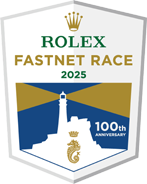Cherbourg-en-Contentin, France 29th July 2025 17:00: After more than two and a half days of mostly upwind sailing, the leaders in IRC Three rounded the Fastnet Rock in the early hours of this morning, followed by the first IRC Four boats a couple of hours later. The bulk of the competitors in these fleets are now enjoying a downwind ride back across the Celtic Sea, which started in around 14-15 knots of breeze for the leaders but could rise to 20-25 knots.
IRC Three
Part of the enduring appeal of the Rolex Fastnet Race – and a keen topic of conversation among teams after the finish – is undoubtedly that there are few uniform experiences of the race, even within the same class.
Andrew Tseng’s Quailo III © Paul Wyeth/PW Pictures/RORC
“We had an amazing leg to the Fastnet Rock, with a lot of tactical and strategic choices that made great racing,” says RORC Rear Commodore Andrew Tseng, whose Nicholson 55 Quailo lll rounded the Rock around 0530 BST this morning. “It’s been a joy, with almost champagne sailing at times, but also very intense. We were at the Rock just at daybreak as the light was just coming up so we could actually see it.”
He says that sight was among a number of “fantastic experiences” so far, which also include “an amazing star scene a couple of nights ago, when we had a completely clear sky,” and spectacular bioluminescence surrounding dolphins, “so it looked as though we were being torpedoed as they came towards us.”
Sebastien Saulnier and 19-year-old Ambre Duchemin rounded three-and-a-half hours later on the Sun Fast 3300 Moshimoshi in 56th place in both IRC Three and IRC Two Handed, allowing for IRC time correction.
“We’ve been having a very good time but it was uncomfortable last night,” says Saulnier. “There was more wind than the GRIB files predicted – 25 knots at times – and a very, very short sea with the boat slamming a lot.”
While this is the first Rolex Fastnet Race for both sailors, Saulnier has a wealth of experience and took an impressive fourth place in the 4,000 mile Transquadra race earlier this year. It underscores just how many challenges must be overcome to get anywhere near to the front of a Rolex Fastnet Race class.
Kuba Symanski, racing two handed with long-term co-skipper Maciek Lato on the First 40.7 Polished Manx 2, reports having experienced less wind than expected, with the exception of a number of squalls, one of which produced a gust over 30 knots at 0100 this morning. He is competing in his seventh Rolex Fastnet Race and routinely notches up 12,000 miles a year sailing Polished Manx.
At 0530 BST this morning, they were sailing upwind in 21 knots with a double reefed mainsail and J3 jib. “We’re enjoying it immensely,” he says. “We love this race and long sails of 600 and 700 miles double-handed. We’re also in very good company – there are 10 Polish boats and five 40.7s, most of which are nearby.”
Having sailed four times around Britain, “two of them upwind almost all the way,” Gavin Howe on the Sun Fast 3600 Tigress is no stranger to conditions other people find uncomfortable. Nevertheless, as one of the few remaining Sun Fast 3600s with a conventional symmetric spinnaker, he was looking forward to the long downwind legs and being able to claw places back from some of the asymmetric rigged boats.
At midday the IRC Three leader, Philippe Girardin’s J/120 Hey Jude was roughly 65 miles west-northwest of the Isles of Scilly having already covered 60 per cent of the distance from the Rock to the archipelago. Hey Jude was followed closely by the British Army’s Sun Fast 3600 Fujitsu British Soldier, and Denis and Annamarie Murphy’s Irish Grand Soleil 40 Nieulargo.
Sam White and Sam North on the JPK 10.80 Mzungu! were the leading two-handed boat in the class, in fourth place, followed by RORC Commodore Deb Fish and Rob Craigie in Bellino, another Sun Fast 3600.
IRC Four
The windshift predicted yesterday may have proved elusive for IRC Three competitors as they tacked up towards the Rock. However, that was certainly not universally the case for all IRC Four boats.
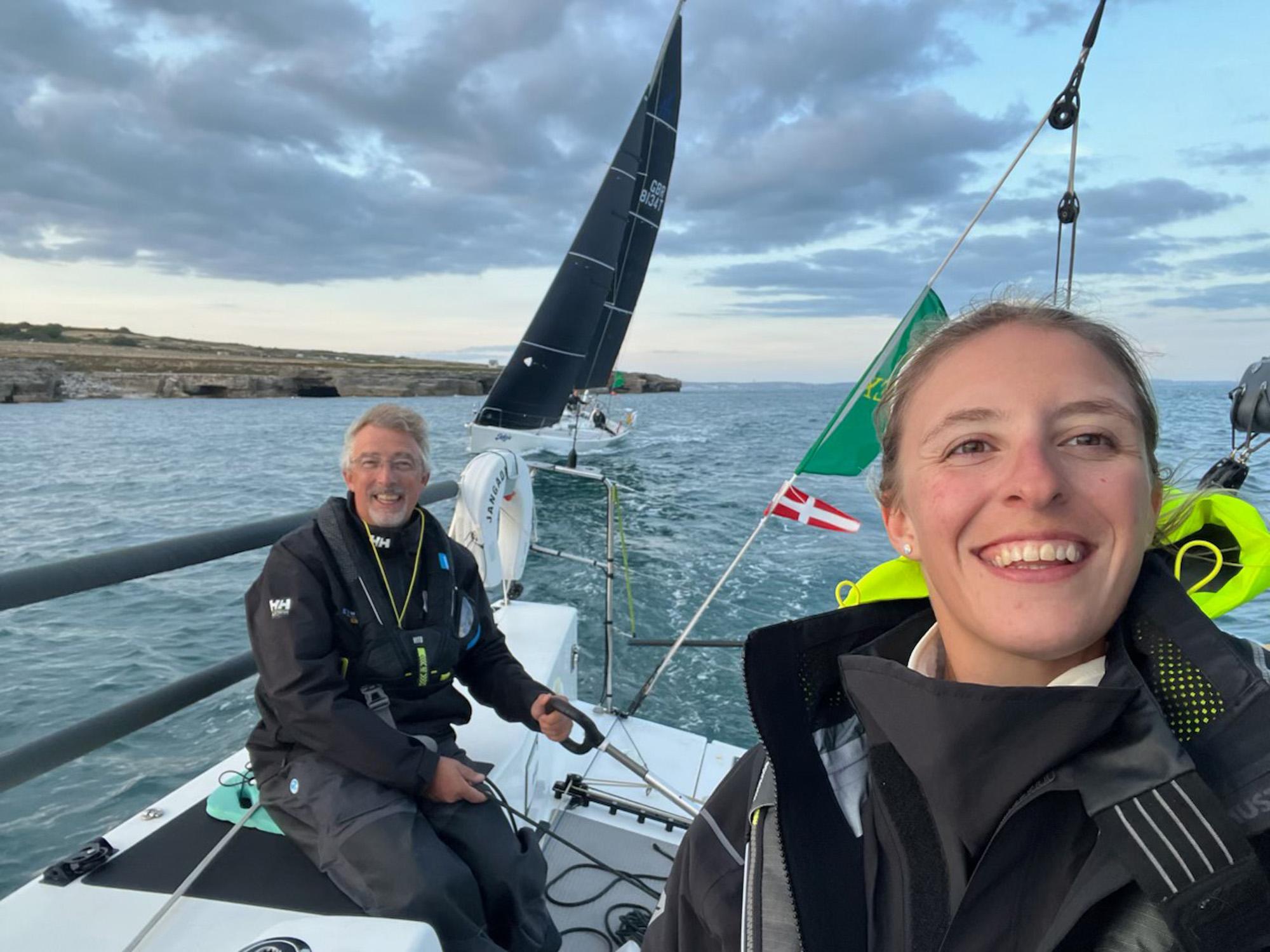 All smiles from Richard and Sophie Palmer on Jangada © Jangada
All smiles from Richard and Sophie Palmer on Jangada © Jangada
“We definitely got the left shift,” says Richard Palmer who’s racing two-handed with his daughter Sophie on the JPK 1010 Jangada. “We called the lay line from about 100 miles away and were only one mile off the corner of the Fastnet TSS when we reached it,” he adds.
He says the leg to the Rock was sailed in “dream conditions – a really classic Fastnet Race windward leg, with nothing too severe – a consistent 20 to 22 knots with a maximum of 24 at the top end. We popped one reef in the mainsail and stayed with the J3 so had very little work in terms of sail transitions and just twisted the sails off to depower.”
Richard and Emma Breese are also a double-handed father and daughter team: “We’ve managed to get into our sleep patterns fairly well and had the strongest winds we’ve seen overnight, with up to 24 or 25 knots,” says Richard. “There was plenty of water over the decks” of their low-freeboard J/105 Mojo. Emma, who is competing in the race for the first time, adds: “It’s been tough at times, but I’m enjoying it, especially seeing the Rock and all the dolphins.”
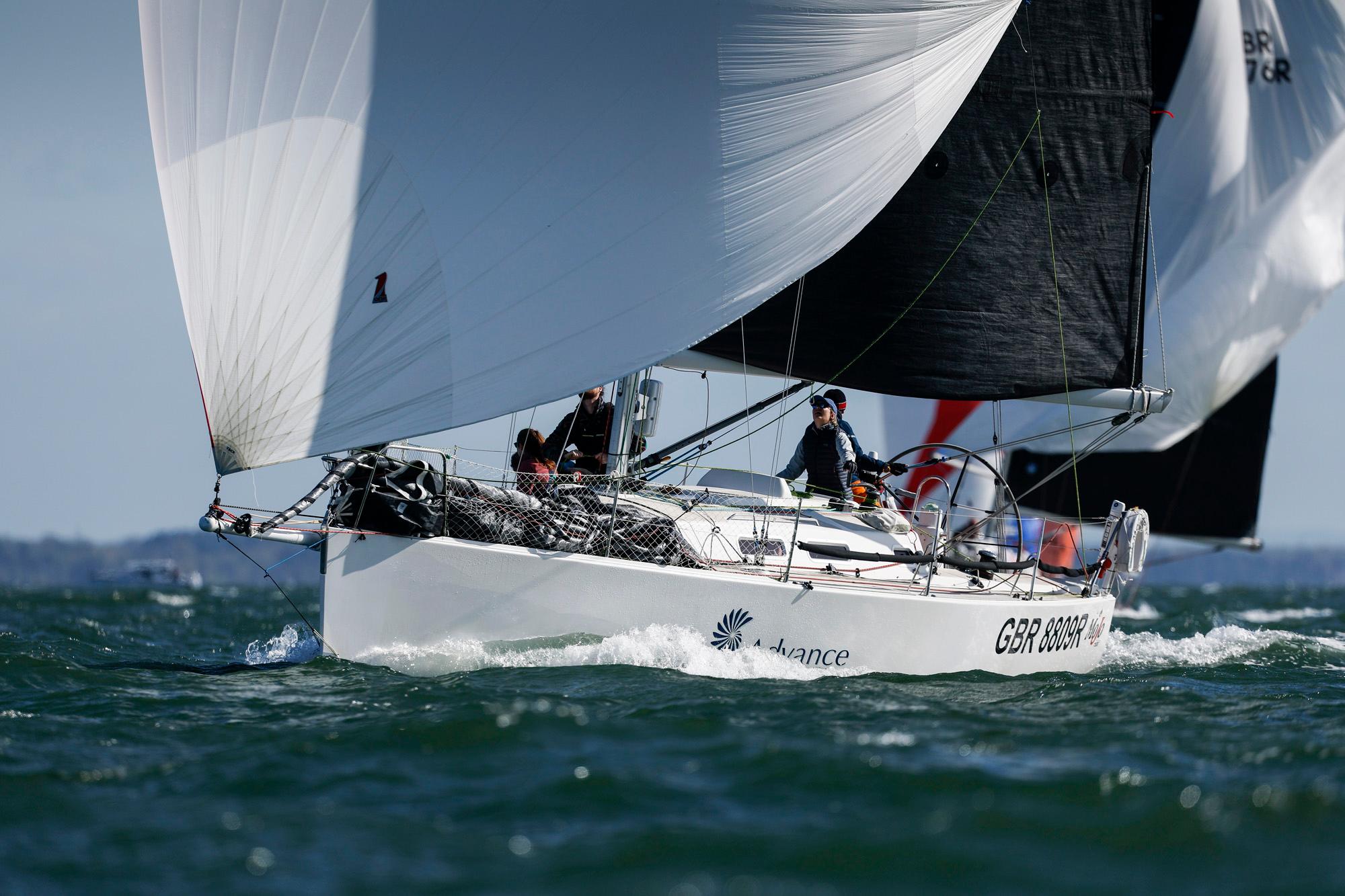 Rob Cotteril’s J/109 Mojo Risin © Paul Wyeth/PW Pictures/RORC
Rob Cotteril’s J/109 Mojo Risin © Paul Wyeth/PW Pictures/RORC
Rob Cotteril’s J/109 Mojo Risin is racing with a team of seven people, with three on each watch and Cotteril floating as skipper, navigator and cook. “It’s working really well and it means we’ve all got somewhere comfortable to sleep,” Claire Dresser reported from on board as they approached the Rock.
As with other boats to the east of the rhumb line, last night they reported more squalls than those further west, with some giving gusts of 30 knots, which resulted in a lot of sail changing.
Yesterday the leaderboard for this class turned inside out as the leaders headed west to take best advantage of the forecast wind shift that would come later. However, as the fleet progressively neared the Fastnet Rock, the leaderboard reverted to form.
Ludovic Menahes’ JPK 1010 Raphael rounded the Rock with an impressive 45 minute lead (after IRC time correction) on sistership Garuda lV, sailed by Ondrej Vachel and Pavel Roubal. At 1400 BST today these boats were 75 miles west-northwest of the Isles of Scilly, while the 94-strong fleet now extends along a whopping 170 miles of the race track.
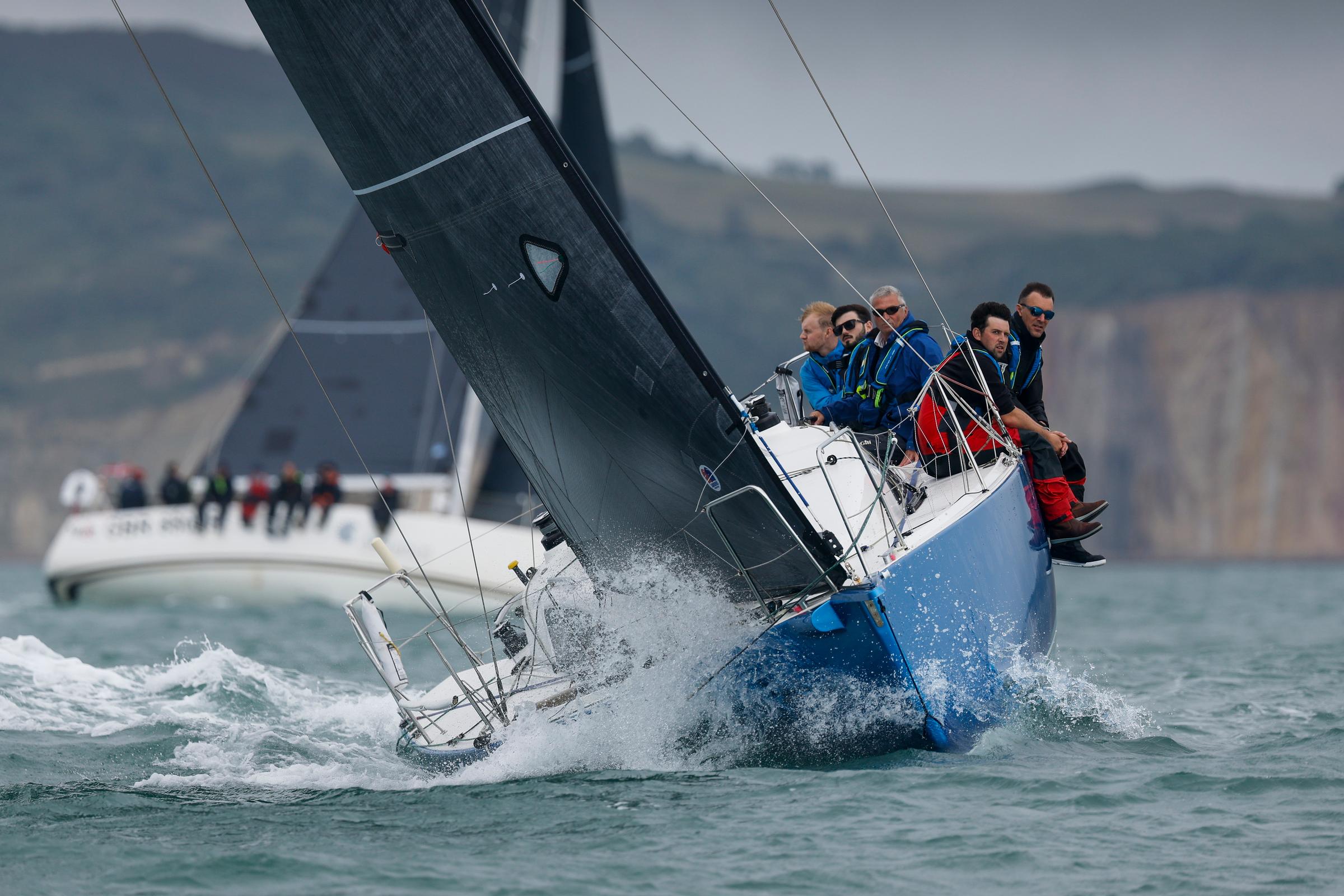 Mark Brown’s Jetpack © Paul Wyeth/PW Pictures/RORC
Mark Brown’s Jetpack © Paul Wyeth/PW Pictures/RORC
The first eight IRC Four boats are all French, leaving Jetpack a JPK 1010 skippered by Mark Brown, with a mostly young crew from Generation JOG, and Radboud Crul’s Dutch Dehler 36 Rosetta, as the only none-French competitors in the top 10.
IRC Two Handed
As with IRC Four, the top of the double handed leaderboard is currently dominated by French entries, with only minor changes in the past 24 hours. Jean-Pierre Kelbert and Alexis Loison’s JPK 1050 Léon remains in the lead, ahead of Didier Gaudoux’s MN35 Lann Ael 3, with Ludovic Gerard and Eliott Coville on sister ship Solenn for Pure Ocean third.
Mzungo! and Bellino, in sixth and seventh places respectively, are the only non-French boats in the top 10. However, conditions in the race to date have favoured the faster, higher rated boats that dominate the higher echelons of the overall IRC scoreboard. And, all the top five double handers are higher rated boats racing in IRC Class 2, with Leon currently sixth overall in the entire IRC fleet.
Meticulous preparation is a vital pre-requisite for success in long distance offshore races. However, you also need a degree of luck on your side. Nick Martin and Jim Driver on the Sun Fast 3600 Diablo are one of the most experienced two-handed teams in this edition of the race. And Diablo’s A2 spinnaker was almost new at the start, having only been used once. Yet the sail blew apart five minutes after hoisting it at the start of the return leg this morning.
This shouldn’t have been a problem as they elected to take another A2 as a spare spinnaker but within 10 minutes that ripped to an extent it could not be repaired on board. “Our third choice of kite was an A3,” says Martin. “It’s a bit more robust but not as good downwind. We’ve had that up for the last few hours and we’re handling it well, using the pilot to steer while we trim. “It’s very hands-on, but it has made us less competitive, so it’s not the ideal situation we wanted, where we would be passing other boats with a beautiful A2 set – that idea is gone.
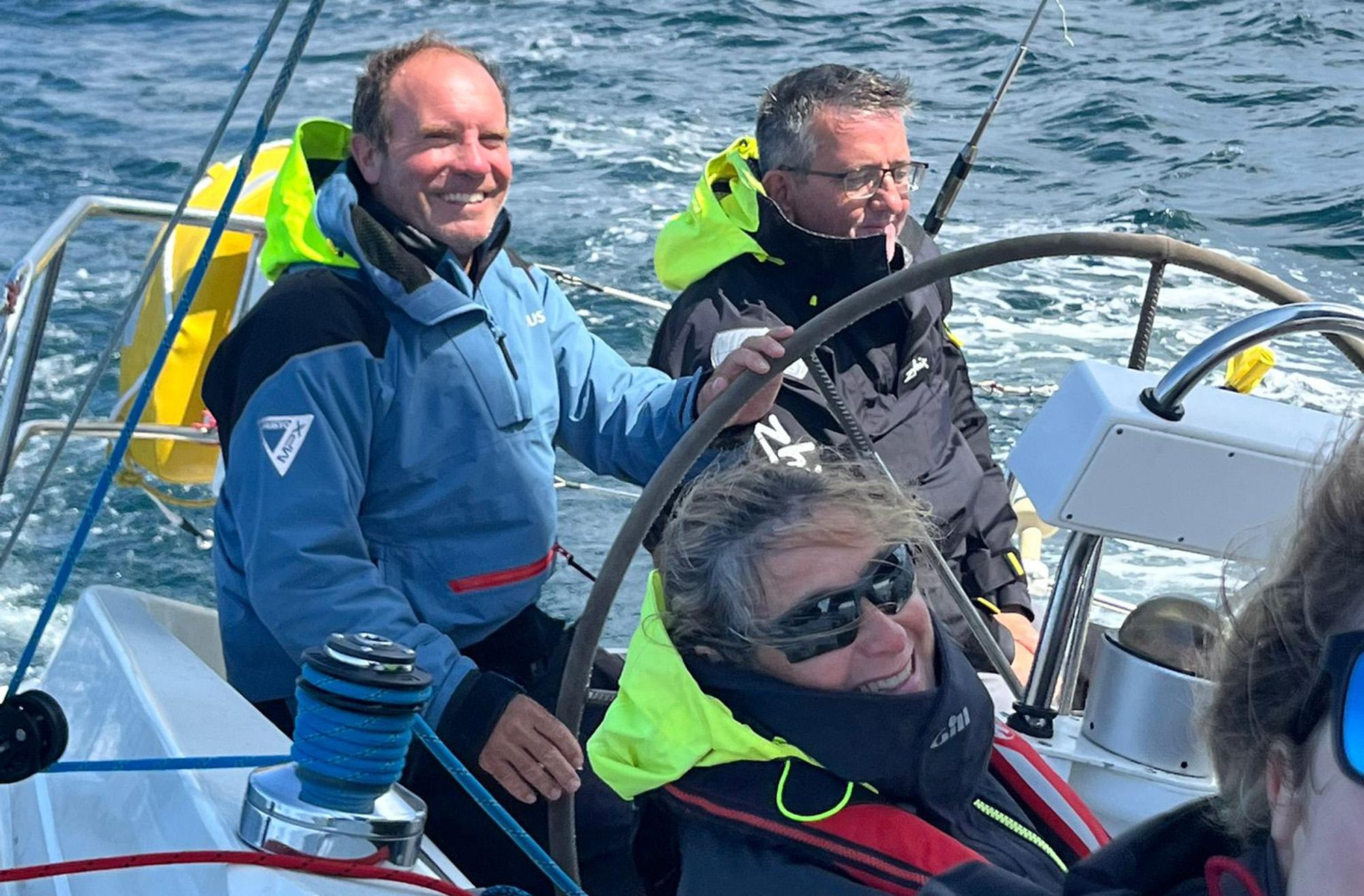 Chris Choules and crew on IRC Four’s With Alacrity enjoy race conditions © With Alactrity
Chris Choules and crew on IRC Four’s With Alacrity enjoy race conditions © With Alactrity
